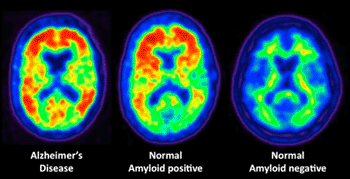Lifelong Brain-Stimulating Practices Leads to Lower Alzheimer’s Protein Levels
By MedImaging International staff writers
Posted on 01 Feb 2012
Neuroimaging scans have revealed that individuals with no symptoms of Alzheimer’s who engaged in cognitively stimulating activities throughout their lives had fewer deposits of beta-amyloid, a destructive protein that is major characteristic of the disease.Posted on 01 Feb 2012
Whereas earlier studies have implied that engaging in mentally stimulating activities--such as reading, writing, and playing games--may help stave off Alzheimer’s disease later in life, this new study identifies the biologic target at play. This finding could guide future research into effective prevention strategies.

Image: PET scans reveal amyloid plaques, which appear as warm colors such as red and orange. The middle scan is from a person with no symptoms of cognitive problems, but with evident levels of amyloid plaque in the brain (Photo courtesy of Susan Landau and William Jagust).
“These findings point to a new way of thinking about how cognitive engagement throughout life affects the brain,” said study lead investigator Dr. William Jagust, a professor with joint appointments at University of California, Berkeley’s (USA) Helen Wills Neuroscience Institute, the School of Public Health and Lawrence Berkeley National Laboratory. “Rather than simply providing resistance to Alzheimer’s, brain-stimulating activities may affect a primary pathological process in the disease. This suggests that cognitive therapies could have significant disease-modifying treatment benefits if applied early enough, before symptoms appear.”
The new study, published January 23, 2012, in the journal Archives of Neurology, places the focus on amyloid--protein fibers folded into tangled plaques that accumulate in the brain. Beta-amyloid is considered the top culprit in the pathology of Alzheimer’s disease; therefore, finding a way to reduce its development has become a major new direction of research.
The researchers noted that the buildup of amyloid can also be influenced by genes and aging-- one-third of people age 60 and over have some amyloid deposits in their brain--but how much reading and writing one does is under each individual’s control. “This is the first time cognitive activity level has been related to amyloid buildup in the brain,” said study lead author Dr. Susan Landau, research scientist at the Helen Wills Neuroscience Institute and the Berkeley Lab. “Amyloid probably starts accumulating many years before symptoms appear. So it’s possible that by the time you have symptoms of Alzheimer’s, like memory problems, there is little that can be done to stop disease progression. The time for intervention may be much sooner, which is why we’re trying to identify whether lifestyle factors might be related to the earliest possible changes.”
The researchers asked 65 healthy, cognitively normal adults aged 60 and over (median age was 76) to rate how frequently they participated in such mentally stilmulating activities as going to the library, reading books or newspapers, and writing letters or email. The questions focused on various points in life from age six to the present.
The participants took part in extensive neuropsychologic testing to evaluate memory and other cognitive functions, and received positron emission tomography (PET) scans at the Berkeley Lab using a new tracer called Pittsburgh compound B that was developed to visualize amyloid. The results of the brain scans of healthy older individuals with various levels of lifetime cognitive activity were compared with those of 10 patients diagnosed with Alzheimer’s disease and 11 healthy individuals in their 20s.
The researchers discovered a significant association between higher levels of cognitive activity over a lifetime and lower levels of beta-amyloid in the PET scans. They analyzed the impact of other factors such as memory function, physical activity, self-rated memory ability, level of education and gender, and found that lifelong cognitive engagement was independently linked to amyloid deposition.
Significantly, the researchers did not find a strong connection between amyloid deposition and levels of current cognitive activity alone. “What our data suggest is that a whole lifetime of engaging in these activities has a bigger effect than being cognitively active just in older age,” said Dr. Landau.
The researchers stressed that the study does not contradict the benefits of jolting brain activity in later years. “There is no downside to cognitive activity. It can only be beneficial, even if for reasons other than reducing amyloid in the brain, including social stimulation and empowerment,” said Dr. Jagust. “And actually, cognitive activity late in life may well turn out to be beneficial for reducing amyloid. We just haven’t found that connection yet.”
Other researchers involved in the study were from the University California (UC) San Francisco’s (USA) Memory and Aging Center and department of neurology, and Rush University Medical Center’s Alzheimer’s Disease Center (Chicago, IL, USA).
Related Links:
University of California, Berkeley
University California, San Francisco
Rush University Medical Center’s Alzheimer’s Disease Center













